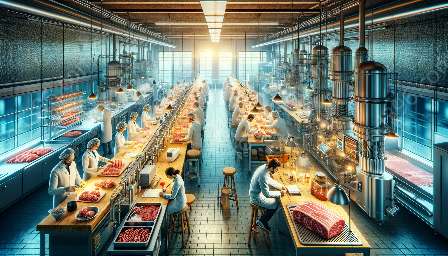Meat safety and microbiology are crucial aspects of the meat industry, influencing meat product development and meat science in profound ways.
The Importance of Meat Safety
Ensuring the safety of meat is essential for protecting consumer health and minimizing the risk of foodborne illnesses. The presence of harmful microorganisms, such as bacteria, viruses, and parasites, in meat can lead to severe health consequences when consumed. Therefore, thorough safety measures are indispensable.
Microbial Contamination
Meat can become contaminated with various microorganisms during processing, storage, and handling. Bacteria like E. coli, Salmonella, and Listeria are common culprits and can proliferate if proper hygiene practices are not followed. To combat this, the meat industry employs stringent protocols to control and prevent microbial contamination.
- Sanitary Practices: Meat processing facilities adhere to strict hygiene protocols to minimize the risk of contamination. Regular cleaning, disinfection, and maintenance of equipment and facilities are essential to prevent the proliferation of harmful microorganisms.
- Temperature Control: Maintaining proper temperature conditions during meat processing and storage is critical in preventing microbial growth. Cold storage and transportation help reduce the risk of bacterial contamination and spoilage.
- Testing and Monitoring: Regular microbial testing and monitoring at different stages of meat production help detect and address potential contamination issues, ensuring the safety of the meat products.
Microbiology and Meat Product Development
The field of meat product development relies heavily on a thorough understanding of microbiology to create safe and high-quality meat products. Microorganisms play a dual role in meat processing and production, as they can either enhance or compromise the quality and safety of meat products.
Microbial Role in Meat Fermentation
Fermentation is a widely used technique in meat product development, and microbiology plays a pivotal role in this process. Beneficial microorganisms, such as lactic acid bacteria, are employed to ferment meat products, contributing to flavor, texture, and shelf life enhancement. Understanding the behavior and interactions of these microorganisms is crucial for successful fermentation and the development of desirable meat products.
Preservation and Safety
Microbiology also influences meat preservation methods, as certain microorganisms can be used to inhibit the growth of harmful pathogens and spoilage organisms. Techniques such as curing, smoking, and the addition of beneficial microorganisms contribute to the safety and extended shelf life of meat products. Conversely, understanding the potential risks associated with pathogenic microorganisms is essential for implementing effective safety measures to protect consumers.
Application of Meat Science
Meat science integrates the principles of food science, biochemistry, and engineering to understand the properties and behaviors of meat. In the context of meat safety and microbiology, meat science plays a critical role in developing and implementing technologies and processes aimed at ensuring the safety and quality of meat products.
Advanced Analytical Techniques
Meat science encompasses advanced analytical techniques that aid in the detection and identification of microorganisms, pathogens, and contaminants in meat products. These techniques, including PCR, DNA sequencing, and mass spectrometry, enable precise and rapid assessment of microbial safety, facilitating the development of targeted control measures.
Innovative Preservation Methods
Advancements in meat science have led to the exploration of innovative preservation methods that leverage microbiological principles. Controlled atmospheres, high-pressure processing, and natural antimicrobial compounds derived from microorganisms are examples of novel techniques that enhance meat safety and prolong shelf life, aligning with the principles of sustainable food production.
Regulatory Compliance
Meat safety and microbiology are subject to stringent regulatory standards and guidelines enforced by governmental agencies. Meat scientists are integral in interpreting and implementing these regulations, ensuring that meat products meet the requisite safety criteria and comply with microbiological standards.
Conclusion
Meat safety and microbiology are foundational pillars in the realm of meat product development and meat science. The understanding and application of microbiological principles are indispensable for guaranteeing the safety, quality, and innovation of meat products. As technological advancements and scientific discoveries continue to unfold, the significance of meat safety and microbiology in the meat industry will persist as fundamental components of sustainable and responsible meat production.

